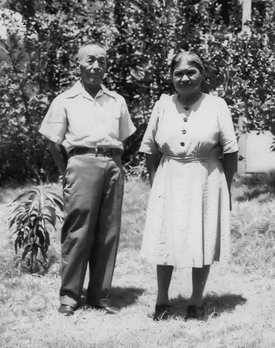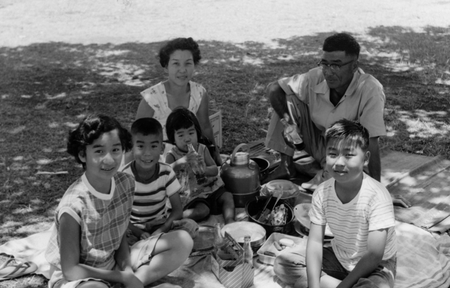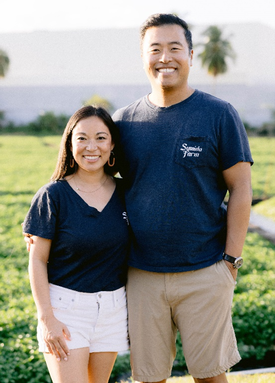
It may be surprising to learn that in June 2014, a study published in the Preventing Chronic Disease peer-reviewed journal showed that watercress, with a perfect nutrient density score of 100, is at the top of the powerhouse fruits and vegetables list.1 Low in calories and high in antioxidants, watercress is in the same family as cabbage and broccoli.
According to Healthline, one cup of watercress provides 22 percent of the Reference Daily Intake (RDI) for vitamin A, 24 percent of the RDI for vitamin C, and 106 percent of the RDI for vitamin K, a nutrient essential for blood clotting and healthy bones.2
That 2014 study didn’t exist when I was a child, so my mother came up with a very clever strategy to teach me to eat vegetables. She would serve a vegetable side dish as the first course and because I was hungry, I would happily eat it.
Growing up in Hawai‘i, I enjoyed the local Sumida Farm watercress in sukiyaki, pork tofu, and chicken noodle soup. As I got older, I appreciated the taste of their fresh watercress in salads. However, I’ve never thought about the history of the farm nor what it takes to supply our islands with their precious crop, that is, until now.
“Eat Plenty Watercress”

Emi Suzuki is the fourth-generation steward of Sumida Farm, located in ‘Aiea on the island of O‘ahu. Her great-grandparents, Moriichi and Makiyo Sumida, immigrated to Hawai‘i from Hiroshima Prefecture in 1907. After working on a sugar plantation, they decided to embrace their entrepreneurial spirit and acquired a dairy in Pearl City. When an opportunity to lease five acres of land from Bishop Estate (now called Kamehameha Schools) arose, they took it. In 1928, they started Sumida Farm and never looked back.
Why focus on watercress? Emi explained, “My great-grandparents wanted to grow a year-round crop that would nourish local families. They realized that the combination of fresh water from Kalauao Spring that flows on the land and Hawai‘i’s climate were ideal conditions to grow watercress.”
The Stuff Legends are Made of
Emi’s grandparents, Masaru and Norma Sumida, became the second-generation stewards of the farm in 1952. Her grandfather was an innovator who introduced modern agricultural methods to improve the operation of the farm. During this generation, the lease was expanded to 10 acres and the terraced land was regraded so that the water could flow evenly throughout the fields. In 1960, Masaru organized a cooperative of over a dozen watercress farms in Pearl City. Only Sumida Farm and one other farm are still surviving today.

Masaru was also the first president of the Hawai‘i Farm Bureau, serving from 1959 to 1966. One of his major contributions was the vacuum cooling machine that he designed, built, and installed for his farm as well as for other farms to utilize. The first of its kind in Hawai‘i, this vacuum cooler was used from 1960 until it was replaced just last year.
In the early 1970s, Masaru fought a colossal battle with the developer of Pearlridge Center. In a proposal sent to Bishop Estate, the developer laid out plans to pave over the farm for the construction of a parking lot. Not to be deterred, Emi’s grandfather stepped up to the plate and hit a grand slam with his counterproposal. He gained the support of local politicians, the Farm Bureau, and the community. Needless to say, Bishop Estate chose the farm. It was a gigantic victory for Masaru and Sumida Farm.
Siblings Take the Reins
Masaru and Norma had four children: Charlotte, Stephen, David, and Barbara. As the oldest son, Stephen felt he would one day take over the management of the farm, but his career in education ended up taking him on a different path. His younger siblings took on the responsibility of being the third-generation stewards in the early 1980s. Barbara, who majored in tropical agriculture from the University of Hawai‘i (UH), was trained by her mother to be the president and general manager. David, who graduated from UH with a degree in art, became the operations manager.

Under their watch, more than 3,000 keiki (children) visited the farm each year on school field trips. As the farm’s tour guide, David hoped that they would gain an appreciation for the ‘āina (land). This community outreach is one of the reasons why local residents feel a special connection to Sumida Farm.
You are Unique and That is Your Superpower
Born in Pullman, Washington, and raised on the mainland, Emi is the only child of Stephen Sumida and Gail Nomura. Her parents moved from Hawai‘i to the mainland for their teaching careers. They taught Asian American Studies at Washington State University, the University of Michigan, and the University of Washington.
Emi met classmate Kyle Suzuki in high school and they started dating in their senior year. She graduated from the University of Washington with a degree in communications and has since been working in health care sales and market access. In 2008, she and Kyle were married. They live in Seattle with their three daughters: Clare (11), Alice (8), and Margaret (9 months).
In addition to running the farm, Emi has a full-time job in Seattle. Kyle, on the other hand, left his corporate marketing job in 2022 to manage the farm full time. They travel back and forth from Seattle to Honolulu on a regular basis.
Recently, I spoke with Emi on a number of topics and she graciously answered my questions below.
* * * * *
LK: In 2018, why did you decide to take on the management of the farm?
ES: After over a decade working for large corporations, my husband and I wanted to start a business where we could create our own company culture based on the good/bad we had learned through working in corporate America. We were less concerned about what we would sell or do, but very focused on the values we would center the business around.
I had a lightning strike moment of inspiration when reading an airline magazine article about Hawai‘i farms and realized we didn’t need to start anything new. My family’s multigenerational farm already embodied everything we wanted: a business, which is run with great integrity and kindness, with a purpose of caring for the land, feeding people, and serving the community through education.
Looking back on this moment of realization, I now know the decision was a lifetime in the making. My parents raised me to understand the history and significance of our farm, and provided opportunities to form my own connection with the ‘āina. These lessons and memories were the foundation for wanting to ensure the farm continued for our kids’ generation and beyond.
LK: A nine-year transition plan was in progress, but in 2020, that plan changed drastically. What were the biggest challenges that you faced?
ES: The unexpected and sudden transition of management when my aunt got sick was a tremendous challenge for us to overcome. As we scrambled to stabilize the business through that abrupt tragedy, COVID-19 was officially recognized as a pandemic and our business, along with every business across the globe, was turned upside down.
We had to pivot our distribution and customer base, apply for PPP loans, deal with major infrastructure issues, and come up with plans for the health and safety of our employees. Most importantly, we had to still care for our daughters, who were at the time ages seven and four.
I will always look back at that year as one of the hardest years of my life. But knowing we were able to persevere and didn’t need to lay off any employees also made it one of the most rewarding and empowering years of my life.
Notes:
1. Jennifer Di Noia, “Defining Powerhouse Fruits and Vegetables: A Nutrient Density Approach,” Preventing Chronic Disease 11 (June 2014).
2. Melissa Groves, “10 Impressive Health Benefits of Watercress,” Healthline, August 6, 2018.
© 2024 Lois Kajiwara






